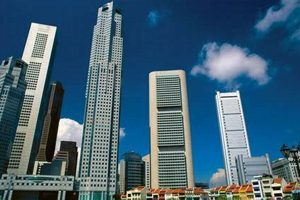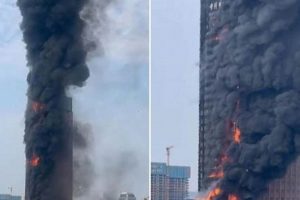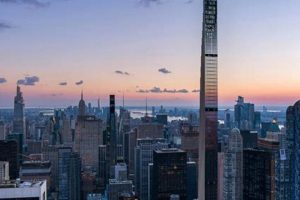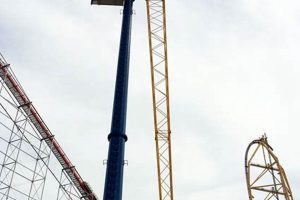Skyscrapers have become an iconic part of Hong Kong’s skyline, symbolizing the city’s economic and architectural prowess. These towering structures offer breathtaking views, luxurious amenities, and environmentally friendly features.
The first skyscraper in Hong Kong was the Bank of China Tower, completed in 1990. Since then, many other skyscrapers have been built, including the International Commerce Centre (ICC), the Two International Finance Centre (2 IFC), and the Central Plaza. These buildings are not only architectural marvels but also house offices, hotels, and retail spaces, making them vital to the city’s economy.
In addition to their economic importance, skyscrapers in Hong Kong are also notable for their sustainable design features. Many of these buildings are equipped with energy-efficient lighting systems, rainwater harvesting systems, and green roofs, which help to reduce their environmental impact.
1. Height
Height is a defining characteristic of skyscrapers in Hong Kong. The city is home to some of the tallest buildings in the world, with the International Commerce Centre (ICC) being the tallest at 484 meters. The height of skyscrapers in Hong Kong is a result of several factors, including the city’s limited land area and its desire to create a vertical city.
The height of skyscrapers in Hong Kong has several advantages. First, it allows for more efficient use of land. By building up, rather than out, Hong Kong can accommodate more people and businesses in a smaller space. Second, tall buildings can provide panoramic views of the city and the surrounding area. Third, tall buildings can be more energy-efficient, as they can take advantage of natural ventilation and daylighting.
However, the height of skyscrapers in Hong Kong also presents some challenges. One challenge is the need for specialized construction techniques and materials. Another challenge is the need for fire safety measures and evacuation plans. Additionally, tall buildings can be more susceptible to wind damage and earthquakes.
Overall, the height of skyscrapers in Hong Kong is a reflection of the city’s unique circumstances and its desire to be a global financial and commercial center. Despite the challenges, the height of skyscrapers in Hong Kong has brought many benefits to the city, including increased land use efficiency, panoramic views, and energy efficiency.
2. Architecture
Architecture plays a vital role in the development and perception of skyscrapers in Hong Kong. The city’s skyscrapers are renowned for their innovative and iconic designs, which have shaped Hong Kong’s skyline and made it one of the most recognizable cities in the world.
One of the most important aspects of skyscraper architecture in Hong Kong is the use of mixed-use developments. This approach combines different functions, such as residential, commercial, and retail, into a single building. This makes skyscrapers more efficient and sustainable, as it reduces the need for people to travel long distances for work, shopping, or leisure activities. Mixed-use developments also create a more vibrant and lively urban environment.
Another important aspect of skyscraper architecture in Hong Kong is the use of sustainable design features. Many of the city’s skyscrapers are equipped with energy-efficient lighting systems, rainwater harvesting systems, and green roofs, which help to reduce their environmental impact. This is important in a city like Hong Kong, where land is scarce and resources are limited.
The architecture of skyscrapers in Hong Kong is also influenced by the city’s unique geography. Hong Kong is a densely populated city with a limited amount of land available for development. This has led to the development of tall and slender skyscrapers, which can maximize the use of space.
Overall, the architecture of skyscrapers in Hong Kong is a reflection of the city’s unique circumstances and its desire to be a global financial and commercial center. The city’s skyscrapers are innovative, sustainable, and efficient, and they have played a major role in shaping Hong Kong’s skyline and identity.
3. Sustainability
Sustainability is a major consideration in the design and construction of skyscrapers in Hong Kong. The city is committed to green building practices, and many of its skyscrapers are equipped with energy-efficient lighting systems, rainwater harvesting systems, and green roofs.
- Energy efficiency
Skyscrapers in Hong Kong are designed to be energy efficient, using features such as double-glazed windows, LED lighting, and motion-activated sensors. The International Commerce Centre (ICC), for example, is one of the most energy-efficient skyscrapers in the world, and it has achieved a LEED Platinum certification.
- Water conservation
Skyscrapers in Hong Kong also use water conservation measures, such as rainwater harvesting systems and low-flow plumbing fixtures. The Bank of China Tower, for example, has a rainwater harvesting system that collects and reuses rainwater for irrigation and other non-potable uses.
- Green roofs
Green roofs are another common feature of skyscrapers in Hong Kong. Green roofs help to insulate buildings, reduce stormwater runoff, and improve air quality. The HSBC Main Building, for example, has a green roof that covers more than 10,000 square meters.
- Sustainable materials
Skyscrapers in Hong Kong are also constructed using sustainable materials, such as recycled steel and low-VOC paints. The Nina Tower, for example, is made from recycled steel, and it has a low-VOC interior that helps to improve indoor air quality.
The sustainability features of skyscrapers in Hong Kong are not only good for the environment, but they also make good business sense. Green buildings can reduce operating costs, attract tenants, and improve employee productivity. As a result, sustainability is becoming increasingly important in the development of skyscrapers in Hong Kong.
4. Mixed-use
Mixed-use developments, which combine different functions such as residential, commercial, and retail into a single building, are a common feature of skyscrapers in Hong Kong. This approach has several advantages, including:
- Increased land use efficiency: By combining different functions into a single building, mixed-use developments make more effi
cient use of land, which is a scarce resource in Hong Kong. - Reduced travel needs: Mixed-use developments reduce the need for people to travel long distances for work, shopping, or leisure activities, as all of these amenities are available within the same building or complex.
- More vibrant and lively urban environment: Mixed-use developments create a more vibrant and lively urban environment, as they attract people from all walks of life and create a sense of community.
One of the most iconic examples of a mixed-use skyscraper in Hong Kong is the International Commerce Centre (ICC). The ICC is a 118-story skyscraper that houses offices, a hotel, and a shopping mall. The ICC is also home to the Sky100 observation deck, which offers panoramic views of Hong Kong. Another example of a mixed-use skyscraper in Hong Kong is the Nina Tower. The Nina Tower is a 80-story skyscraper that houses offices, a hotel, and a residential complex. The Nina Tower is also home to a rooftop garden, which offers stunning views of the city. Mixed-use developments are an important part of skyscraper design in Hong Kong. They make more efficient use of land, reduce travel needs, and create a more vibrant and lively urban environment.
5. Economic impact
Skyscrapers have a significant economic impact on Hong Kong. They attract businesses and investment from around the world, and they create jobs in construction, property management, and other industries. Skyscrapers also boost tourism, as people come from all over the world to see these iconic buildings.
One of the most important economic benefits of skyscrapers is that they create jobs. The construction of a single skyscraper can create thousands of jobs, and once the building is completed, it will provide jobs for hundreds of people in property management, security, cleaning, and other industries. Skyscrapers also attract businesses and investment from around the world. Many multinational corporations have their regional headquarters in Hong Kong’s skyscrapers, and these companies bring with them jobs and investment.
In addition to creating jobs, skyscrapers also boost tourism. People from all over the world come to Hong Kong to see the city’s iconic skyscrapers, and this tourism revenue helps to support the local economy. For example, the Sky100 observation deck at the International Commerce Centre (ICC) attracts over one million visitors each year.
Overall, skyscrapers have a significant economic impact on Hong Kong. They create jobs, attract businesses and investment, and boost tourism. This economic impact helps to make Hong Kong one of the most prosperous cities in the world.
6. Cultural significance
Skyscrapers are more than just tall buildings; they are also cultural icons that reflect the values and aspirations of a city. In Hong Kong, skyscrapers are seen as symbols of the city’s economic success and global status. They are also admired for their architectural beauty and engineering prowess.
Skyscrapers have had a significant impact on the culture of Hong Kong. They have helped to create a sense of identity and pride among the people of Hong Kong. They have also become popular tourist destinations, attracting visitors from all over the world.
One of the most important cultural aspects of skyscrapers in Hong Kong is their use of feng shui principles. Feng shui is a traditional Chinese system of geomancy that seeks to harmonize the flow of energy in a space. Many skyscrapers in Hong Kong are designed according to feng shui principles, in order to bring good fortune and prosperity to their occupants.
Another important cultural aspect of skyscrapers in Hong Kong is their role in the city’s skyline. The Hong Kong skyline is one of the most iconic in the world, and it is constantly evolving as new skyscrapers are built. The skyline is a source of pride for the people of Hong Kong, and it is often used to represent the city in popular culture.
Overall, skyscrapers are more than just tall buildings in Hong Kong; they are also cultural icons that reflect the values and aspirations of the city. They have had a significant impact on the culture of Hong Kong, and they continue to play an important role in the city’s identity and global image.
7. Technological innovation in skyscraper hk
Skyscrapers in Hong Kong are renowned for their innovative use of technology. This is due in part to the city’s status as a global financial center, which has led to a demand for tall, efficient buildings that can accommodate a large number of people. Hong Kong is also a major center for research and development, which has led to the development of new technologies that can be used in skyscrapers.
- Building materials and construction techniques
Skyscrapers in Hong Kong are constructed using a variety of innovative materials and construction techniques. These include the use of lightweight materials, such as aluminum and glass, which reduce the weight of the building and make it more resistant to earthquakes. Skyscrapers in Hong Kong are also constructed using advanced construction techniques, such as prefabrication and modular construction, which can speed up the construction process and improve quality control.
- Energy efficiency
Skyscrapers in Hong Kong are designed to be energy efficient, using a variety of technologies to reduce their energy consumption. These technologies include the use of energy-efficient lighting systems, HVAC systems, and building envelopes. Skyscrapers in Hong Kong are also equipped with smart grids, which can monitor and control the building’s energy consumption and optimize its efficiency.
- Sustainability
Skyscrapers in Hong Kong are also designed to be sustainable, using a variety of technologies to reduce their environmental impact. These technologies include the use of rainwater harvesting systems, solar panels, and green roofs. Skyscrapers in Hong Kong are also designed to be resilient to climate change, using technologies such as sea walls and storm surge barriers to protect them from flooding and other extreme weather events.
- Smart technology
Skyscrapers in Hong Kong are increasingly using smart technology to improve the safety, security, and convenience of their occupants. These technologies include the use of facial recognition systems, biometric sensors, and smart elevators. Skyscrapers in Hong Kong are also equipped with smart building management systems, which can monitor and control the building’s systems and respond to emergencies.
The use of technological innovation in skyscrapers in Hong Kong is helping to make the city more sustainable, efficient, and resilient. These innovations are also making skyscrapers more attractive to tenants and investors, and they are helping to make Hong Kong a more competitive global financial center.
Here are some frequently asked questions about skyscrapers in Hong Kong, along with their answers:
Question 1: What is the tallest skyscraper in Hon
g Kong?
Answer: The tallest skyscraper in Hong Kong is the International Commerce Centre (ICC), which is 484 meters tall.
Question 2: How many skyscrapers are there in Hong Kong?
Answer: There are over 450 skyscrapers in Hong Kong, which is more than any other city in the world.
Question 3: What are skyscrapers in Hong Kong used for?
Answer: Skyscrapers in Hong Kong are used for a variety of purposes, including offices, residential units, retail space, and hotels.
Question 4: Are skyscrapers in Hong Kong safe?
Answer: Yes, skyscrapers in Hong Kong are safe. They are built to withstand earthquakes and typhoons, and they are equipped with advanced fire safety systems.
Question 5: Are skyscrapers in Hong Kong sustainable?
Answer: Yes, many skyscrapers in Hong Kong are sustainable. They are designed to be energy-efficient and environmentally friendly, and they are equipped with features such as rainwater harvesting systems and solar panels.
Question 6: What is the future of skyscrapers in Hong Kong?
Answer: The future of skyscrapers in Hong Kong is bright. The city is expected to continue to grow and develop, and new skyscrapers will be built to meet the demand for office space, residential units, and other uses.
Summary: Skyscrapers are an important part of the Hong Kong skyline, and they play a vital role in the city’s economy and culture. Skyscrapers in Hong Kong are safe, sustainable, and technologically advanced, and they are expected to continue to play an important role in the city’s future.
Transition to the next article section: Skyscrapers are a global phenomenon, and they can be found in cities all over the world. In the next section, we will take a look at some of the most iconic skyscrapers in the world.
Tips for Working in a Skyscraper in Hong Kong
Working in a skyscraper in Hong Kong can be a rewarding experience, but it is important to be aware of the challenges and to take steps to stay safe and healthy.
Tip 1: Be aware of the fire safety procedures
Skyscrapers are tall buildings, so it is important to be aware of the fire safety procedures in your building. Know where the fire exits are located and how to use them. Also, be aware of the location of the nearest fire alarm and how to activate it.
Tip 2: Take the stairs instead of the elevator
If you are able to, take the stairs instead of the elevator. This will help you to get exercise and avoid the risk of getting stuck in the elevator in the event of a fire or other emergency.
Tip 3: Stay hydrated
The air in skyscrapers can be dry, so it is important to stay hydrated. Drink plenty of water throughout the day, especially if you are working on a high floor.
Tip 4: Get regular eye exams
Working on a computer all day can strain your eyes. Be sure to get regular eye exams and follow your eye doctor’s recommendations for glasses or contact lenses.
Tip 5: Take breaks
It is important to take breaks throughout the day, especially if you are working on a repetitive task. Get up and move around every 20-30 minutes to help prevent eye strain, muscle fatigue, and other health problems.
Summary: Working in a skyscraper in Hong Kong can be a rewarding experience, but it is important to take steps to stay safe and healthy. By following these tips, you can help to reduce your risk of injury or illness and make your work environment more comfortable and productive.
Transition to the article’s conclusion: If you are considering working in a skyscraper in Hong Kong, be sure to research the building and the company you are working for. Also, be sure to take the time to learn about the fire safety procedures and other safety protocols in the building.
Skyscrapers in Hong Kong
Skyscrapers are an iconic part of the Hong Kong skyline, and they play a vital role in the city’s economy and culture. Skyscrapers in Hong Kong are safe, sustainable, and technologically advanced, and they are expected to continue to play an important role in the city’s future.
However, it is important to be aware of the challenges of working in a skyscraper, and to take steps to stay safe and healthy. By following the tips outlined in this article, you can help to reduce your risk of injury or illness and make your work environment more comfortable and productive.
If you are considering working in a skyscraper in Hong Kong, be sure to research the building and the company you are working for. Also, be sure to take the time to learn about the fire safety procedures and other safety protocols in the building.







